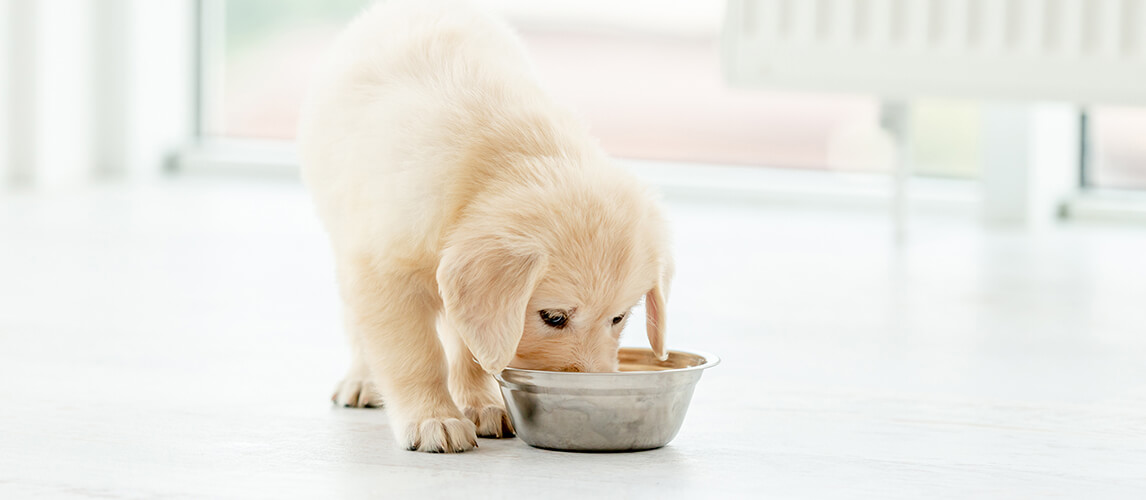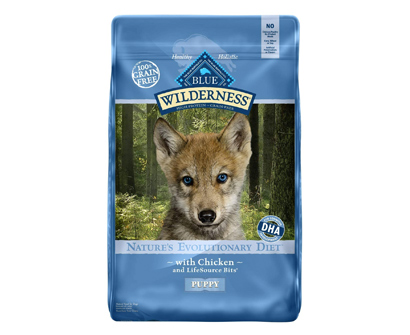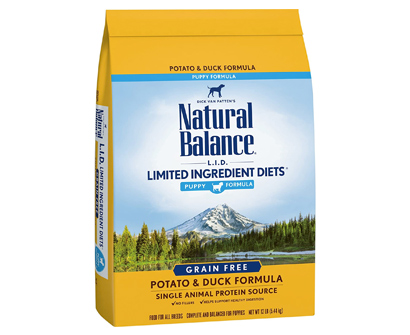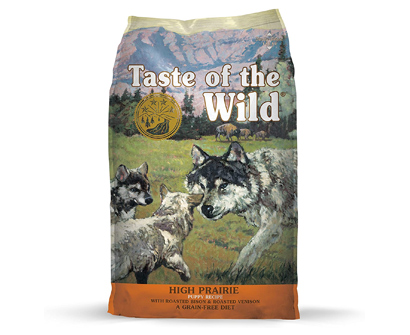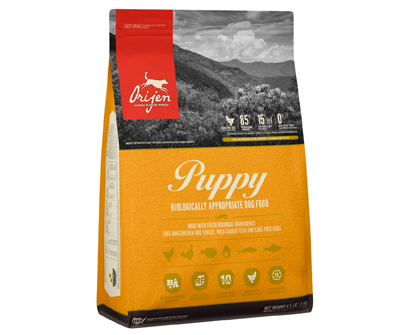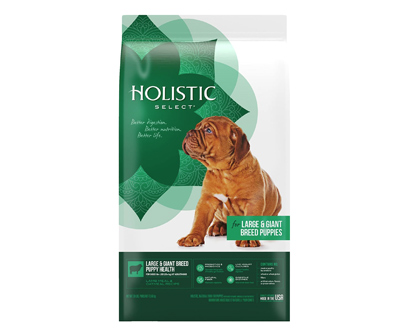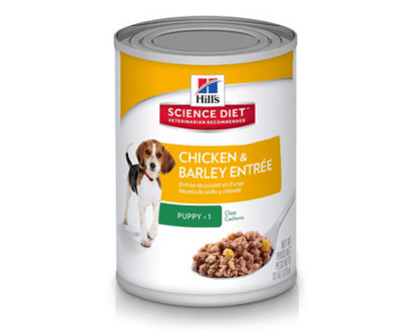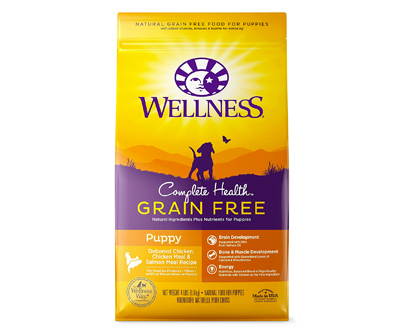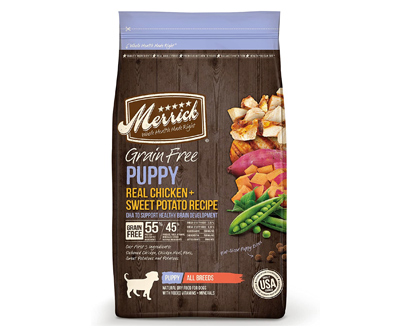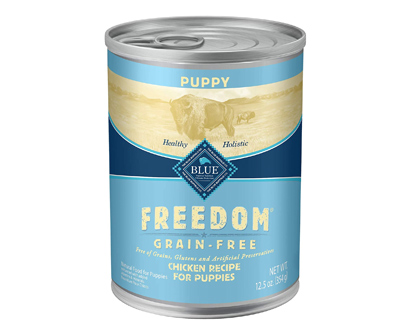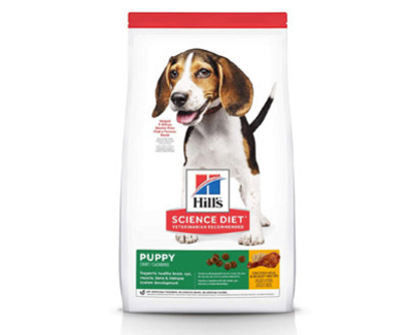- The Best Dog Food for Puppies
- 1. BLUE Wilderness High Protein Grain Free Puppy Food
- 2. Natural Balance Limited Ingredient Puppy Food
- 3. Taste of the Wild Grain Free High Protein Natural Puppy Food
- 4. ORIJEN Puppy Food, Biologically Appropriate & Grain Free
- 5. Holistic Select Natural Puppy Food
- 6. Hill’s Science Diet Puppy Food
- 7. Wellness Complete Health Natural Grain Free Dry Puppy Food
- 8. Merrick Grain Free Puppy Recipe Dry Dog Food
- 9. BLUE Freedom Natural Grain Free Wet Dog Food
- 10. Hill’s Science Diet Dry Puppy Food
The food that you feed your young puppy can affect their health, wellbeing, and development into adulthood. Puppies have very specific dietary needs, and these are best met by high-quality dog food that is formulated specifically for puppies. However, this still leave a vast number of brands and styles of food to choose from, so how can you know that you are buying the right one for your puppy? Our panel of dog loving experts have created a list of the best dog food for puppies to get you started.
The Best Dog Food for Puppies
1. BLUE Wilderness High Protein Grain Free Puppy Food
Key Features
Calories per serving: 418 Kcals per cup
Crude protein minimum: 36%
Crude fat minimum: 16%
Fiber maximum: 5%
Moisture maximum: 10%
Top five ingredients: Deboned chicken, chicken meal, pea protein, peas, tapioca startch
Contains: Calcium, phosphorus, choline, ARA, DHA, omega-3, omega-6, vitamins A, B1, B2, B3, B6, B7, B9, B12, C, and D3
BLUE Wilderness High Protein Grain Free Puppy Dry Dog Food recreates the evolutionary diet that would have been enjoyed by your puppy’s wild ancestors. It contains high-quality protein from meat as its first ingredient and reinforces this with fish meal to help build and maintain strong lean muscles. The protein is balanced with a range of fruits and vegetables, which provide many of the other nutrients, vitamins, and minerals that your puppy needs to grow strong and healthy. It includes sources of DHA to support retinal functions and the development of cognitive learning. As with all BLUE products the food contains LifeSource Bits with their specific blend of vitamins, antioxidants, and minerals. These are cooked at a lower temperature to ensure they maintain their potency and ability to support immune system health and provide a healthy oxidative balance. The formula is grain free, contains no animal by-products, and no artificial colors, flavors, or preservatives.
2. Natural Balance Limited Ingredient Puppy Food
Key Features
Calories per serving: 370 Kcals per cup
Crude protein minimum: 22.5%
Crude fat minimum: 11%
Fiber maximum: 4%
Moisture maximum: 10%
Top five ingredients: Potatoes, duck meal, duck, potato protein, canola oil
Contains: DHA, calcium, phosphorus, omega-3, omega-6, zinc, iron, copper, manganese, sodium, potassium, taurine, vitamins A, B12, D3, and E
Natural Balance Limited Ingredient Dry Dog Food is a grain free puppy food that is specially designed with smaller kibble for smaller teeth and jaws. The limited ingredient formula helps to reduce possible allergies and intolerances by minimizing the number of ingredients that your puppy is exposed to. Duck is the main source of protein and is a good alternative to chicken. Potatoes provide a source of high-quality carbohydrates and are an easily digestible source of energy. The formula includes DHA from salmon oil for neural development support. It is also free from artificial colors, flavors, and preservatives. For a full list of our favorite options, see our round-up of the Best Limited Ingredient Dog Food.
3. Taste of the Wild Grain Free High Protein Natural Puppy Food
Key Features
Calories per serving: 364 Kcals per cup
Crude protein minimum: 28%
Crude fat minimum: 17%
Fiber maximum: 5%
Moisture maximum: 10%
Top five ingredients: Buffalo, lamb meal, sweet potatoes, egg product, pea protein
Contains: DHA, iron, zinc, copper, biotin, niacin, calcium, folic acid, vitamins A, B1, B2, B6, B12, D, and E
The Taste of the Wild High Prairie Puppy formula is made with venison and bison and has meat protein as its top ingredient. This results in a food that is rich in protein and that has an optimal amino acid profile; these combine to help build lean strong muscles in your puppy. The recipe has smaller kibble, which is ideal for smaller jaws and teeth, and is rich in antioxidants and DHA to support brain and eye development. The formula is nutrient rich and high-digestible; it also contains species specific propriety probiotics. Every ingredient in the formula is sourced from a sustainable and trusted source and the recipe is free from wheat, corn and other grains, and contains no artificial colors, flavors, or preservatives. Read our in-depth Taste Of The Wild Dog Food review here.
4. ORIJEN Puppy Food, Biologically Appropriate & Grain Free
Key Features
Calories per serving: 451 Kcals per cup
Crude protein minimum: 38%
Crude fat minimum: 20%
Fiber maximum: 6%
Moisture maximum: 12%
Top five ingredients: Deboned chicken, deboned turkey, yellowtail flounder, whole eggs, whole Atlantic mackerel
Contains: Calcium, phosphorus, omega-3, omega-6, DHA, EPA, glucosamine, and chondroitin sulfate
Orijen Puppy Formula is a biologically appropriate food that includes a single source of protein to support your puppy’s health and development. Made with regional ingredients, it follows a whole prey regime and contains no rendered meals. The formula includes fresh or raw ingredients in its top 10 ingredients and uses no artificial preservatives. Here’s a detailed look at Orijen Dog Food.
5. Holistic Select Natural Puppy Food
Key Features
Calories per serving: 433 Kcals per cup
Crude protein minimum: 25%
Crude fat minimum: 16%
Fiber maximum: 4.5%
Moisture maximum:10%
Top five ingredients: Lamb meal, chicken meal, oatmeal, brown rice, barley
Contains: DHA, calcium, phosphorus, omega-3, omega-6, lactic acid microorganisms, bacillus organisms, protease, cellulase, alpha-amylase, vitamins A, B12, C, D3, and E
Designed specifically to meet the growth and digestive needs of large breed puppies, Holistic Select Natural Dry Dog Food includes prebiotics, probiotics, digestive enzymes, natural fibers, and botanicals. The formula has a larger size kibble than most puppy foods, ideal for accommodating the chewing needs of larger breeds. The complete and balanced food contains premium ingredients, including real lamb, and features DHA for healthy growth. The recipe is free from meat by-products, wheat, and wheat gluten. It contains no artificial colors, flavors, or preservatives.
6. Hill’s Science Diet Puppy Food
Key Features
Calories per serving: 482 Kcals per can
Crude protein minimum: 28.4%
Crude fat minimum: 22.7%
Fiber maximum: 1.7%
Carbohydrate: 39.5%
Top five ingredients: Water, chicken, whole grain corn, cracked pearled barley, soybean meal
Contains: Calcium, phosphorus, sodium, potassium, magnesium, taurine, omega-3, omega-6, vitamins B12, C, D3, and E
Hill’s Science Puppy Food provides precisely balanced nutrition for mobility and immunity support. The wet food formula is created by food scientists, nutritionists, and veterinarians, and combines great tastes with high-quality ingredients to ensure that key nutrients and proteins are available for healthy development. As well as lean protein, the recipe contains gentle fibers for healthy digestion. If you want to find out more about their company, product lines, and recall history, read our review of Hill’s Science Diet Dog Food.
7. Wellness Complete Health Natural Grain Free Dry Puppy Food
Key Features
Calories per serving: 490 Kcals per cup
Crude protein minimum: 32%
Crude fat minimum: 18%
Fiber maximum: 5.5%
Moisture maximum: 10%
Top five ingredients: Deboned chicken, chicken meal, peas, chickpeas, lentils
Contains: DHA, calcium, phosphorus, omega-3, omega-6, taurine, vitamins A, and E
If you are looking for complete and balanced nutrition for your dog without the presence of grains, then Wellness Complete Health Natural Grain Free Dry Dog Food could be just what you are looking for. The formula includes natural sources of protein such as whitefish and chicken and contains all the vitamins and minerals that a growing puppy needs to stay healthy. The recipe is from artificial colors, flavors, and preservatives, and does not contain any wheat, corn, soy, or meat by-products. For more information on the brand, check out our Wellness Core Dog Food review.
8. Merrick Grain Free Puppy Recipe Dry Dog Food
Key Features
Calories per serving: 381 Kcals per cup
Crude protein minimum: 28%
Crude fat minimum: 12%
Fiber maximum: 4.5%
Moisture maximum: 11%
Top five ingredients: Deboned chicken, chicken meal, potatoes, peas, sweet potatoes
Contains: DHA, calcium, phosphorus, omega-3, omega-6, glucosamine, chondroitin sulfate, vitamins A, B12, D3, and E
If you are looking for a gluten free puppy food, then Merrick Grain Free Puppy Recipe Dry Dog Food could be just what you need. The food is easily digested and contains real deboned chicken as its number one ingredient. The formula also contains DHA for healthy brain development. The food is made up of 55% poultry, fish, and healthy fats, while the other 45% includes fresh produce, vitamins, and minerals. The food is designed to meet the needs and developmental requirements of both large and small dog breeds. For more options, check out our detailed review of Merrick Dog Food.
9. BLUE Freedom Natural Grain Free Wet Dog Food
Key Features
Calories per serving: 463 Kcals per can
Crude protein minimum: 9%
Crude fat minimum: 6%
Fiber maximum: 1.5%
Moisture maximum: 78%
Top five ingredients: Chicken, chicken broth, chicken liver, pea flour, carrots
Contains: DHA, omega-3, omega-6, vitamins B1, B2, B3, B5, B6, B7, B9, B12, D3, and E
If your puppy prefers the taste and consistency of wet food, then BLUE Freedom Natural Grain Free Wet Dog Food could be just what you are looking for. The chicken recipe food is rich in protein and contains a range of fruits and vegetables including sweet potatoes, carrots, peas, cranberries, and blueberries. These help to provide the right balance of vitamins, minerals, and nutrients that your growing puppy needs. The formula is free from artificial colors, flavors, and preservatives and does not contain any grains, soy, or poultry by-products.
10. Hill’s Science Diet Dry Puppy Food
Key Features
Calories per serving: 378 Kcals per cup
Crude protein minimum: 30.5%
Crude fat minimum: 19.9%
Fiber maximum: 1.8%
Carbohydrates: 39.7%
Top five ingredients: Chicken meal, cracked pearled barley, pork meal, whole grain wheat, whole grain corn
Contains: Calcium, phosphorus, sodium, potassium, magnesium, DHA, omega-3, omega-6, vitamins A, B12, C, D3, and E
Hill’s Science Diet Dry Puppy food is suitable for puppies up to the age of one and can also be used for pregnant or nursing dogs to help them produce the nutrients required for healthy offspring. The food contains optimal levels of minerals and DHA to support healthy skeletal, eye, and brain development. It also contains a unique blend of vitamins C and E to support your growing puppy’s immune system. The food is made from high-quality, natural ingredients with added amino acids, minerals, and vitamins. It has no artificial colors, flavors, or preservatives.
Best Dog Food for Puppies Buying Guide & FAQ
Our list of the 15 best dog foods for puppies gives you an indication of the best foods that are available. However, to choose the one that is right for your growing puppy, you also need to know more about why these foods are the best, what ingredients should be in puppy food, and exactly what the nutritional needs of puppies are. In this section of the buying guide, we look at each of these elements and answer some of the most frequently asked questions about the best dog food for puppies.
The Ingredients We Want in Best Puppy Food
When looking for the best food for your puppy, you want a food that is balanced and complete. This means it provides everything that your growing puppy needs to stay healthy and develop to their full potential. Here are 10 ingredients that any balanced and complete food should include if it is to be among the best puppy foods that are available.
- Meat
The main ingredient in your puppy food should be protein from a named meat source. Good meat protein sources include beef, chicken, rabbit, venison, and fish. Egg protein is also a good source of protein, but it shouldn’t be the primary source.
- Meat meal
Meal is not the same as by-product. It is simply ground up and dried meat. As long as a single source is given for the meal, then it is a beneficial addition to the food.
- Grains and carbohydrates
Carbohydrates provide energy for your growing puppy and good quality whole grains can aid with digestion. While some foods are completely grain free, it is only lower quality grains such as wheat, corn, and soy that you really want to avoid. Oats, barley, rice, and peas can all be beneficial to your puppy. Find out more about grain free dog food here.
- Vegetables
These are beneficial as they provide a host of vitamins and minerals that puppies need in the modern environment.
- Fruits
While like vegetables they are unlikely to have formed a large part of your dog’s wild evolutionary diet they are beneficial sources of fiber and antioxidants.
- Fats
Your dog needs the right fats to help with digestion and to support proper cell function. High quality fats, such as named fish oils, chicken fat, and olive oil also help your dog absorb certain vitamins and help keep their coat shiny and healthy.
- Vitamins
These help with immune system processes, as well as digestive and metabolic processes. They also help keep the blood cells and nerves healthy. Vitamins A and E should always be present, as should a range of B vitamins including biotin, riboflavin, thiamin, and beta-carotene. Head over to our review of dog vitamins for more options.
- Minerals and nutrients
There are several minerals that are important to your puppy’s heath, including calcium, manganese, iron, zinc, and potassium. L Carnitine is also useful as it helps transport fatty acids and supports cellular energy production. DL-Methionine is one of the 10-plus essential amino acids that your dog requires.
- Preservatives
Natural preservative help keep your dog’s food fresh and ensure that it maintains its levels of nutrients.
- Water
Dogs need to stay hydrated, so moisture is a vital ingredient in their food. However, they should also always have a source of fresh, clean drinking water available, especially if you feed them dry dog food.
You may also like our article on Dog Water Fountains.

The Ingredients We Don’t Want in Best Puppy Food
As well as checking for the foods you do want to see in puppy food, it is important to check for foods that you don’t want to see. Most of the foods you don’t want to see in puppy food fall under the categories of artificial or chemical additives, fillers, or by-products. While most need to be avoided for the health and wellbeing of your puppy, some are best avoided for the health of the planet and the welfare of the animals that are the source of the protein in your puppy’s food. The main foods that you don’t want to see your puppy food are listed below.
- BHA/BHT
These are chemical preservatives that are banned in some countries. The level of harm is still being debated, but there are healthier alternatives and natural preservatives available.
- White flour
This has no nutritional value and is a simple carbohydrate that can cause spikes and sudden drops in blood sugar. Over time it can lead to obesity and canine diabetes. Whole grain foods or even grain free foods are healthier alternatives.
- Non-specific meat
If your food is labelled simply with meat it should be avoided as it could quite literally contain anything that was once alive. Such concoctions require extensive heat treatments to make them safe, which kills most of the nutrients that may have existed. Always look for named meats whose origins can be traced to source.
- Artificial colors
These can affect the biochemical processes of the body and have been linked to hyperactivity. They have no nutritional value and are only used to improve the look of the food.
- MSG
This is a flavor enhancer that is used because it is cheaper than using high-quality and more tasty ingredients. One of the problems with checking for MSG is that it does not have to be specified on pet food labels. However, it often forms a part of other ingredients that are listed, such as: guaylate or disodium inosinate, glutanic acid or glutamate, monopotassium glutamate, calcium caseinate, hydrolyzed yeast, yeast extracts, sodium caseinate, soy concentrate or extracts, autolyzed yeast, natural flavors, texturized protein, protein isolate, and hydrolyzed protein.
- Gluten
There is some controversy as to whether gluten should form part of your dog’s diet, as it would not have formed a substantial part of their evolutionary diet. What is certain is that if your dog has an intolerance to gluten or is showing signs of a potential intolerance or allergy, then it is best avoided.
- Corn syrup
As well as causing spikes and drops in blood sugar, corn syrup is highly addictive, meaning the more your puppy has the more they will want. Ideally you want your puppy to avoid all sugars and high-quality dog foods do not need sugar as they use quality ingredients that provide all the taste your dog needs.
- Farmed salmon
Salmon is a healthy addition to your dog’s diet, but farmed salmon can include harmful toxins. It can include PCBs, mercury, and other fat-soluble toxins that can be harmful. It is always best to specifically check for wild salmon on the ingredients.
For more options head over to our guide on Salmon Oil For Dogs.
- Sugar substitutes
Xylitol can make your puppy very poorly causing issues including seizures and liver failure. Other sugar substitutes can have a similar effect to natural sugars and should also be avoided.
- Nitrates
These are preservatives that are often found in prepared meats, such as bacon, ham, and sausages. Sodium nitrate can be toxic in high doses, so it is best avoided completely.
- Soy
This can be difficult to pets to digest and can cause gas and bloating. It is often included as a filler because it is cheap. However, it is also a common allergen, so is best avoided.
- STPP (Sodium Tripolyphosphate)
STPP is another preservative, it is often found in detergents and is used for softening water. It is also recognized as a rodenticide, insecticide, and fungicide, so not something you want your puppy ingesting.
- Rendered fat
This ingredient should be treated with the same care as generic meat. It can come from anywhere and be full of toxins.
- Propylene glycol
This is an ingredient in antifreeze. It is not as toxic as ethylene glycol, but it is extremely toxic to cats. While your dog can metabolize the ingredient, cats cannot, so if you have a mixed pet household, avoid it completely.
- Vegetable oil
This is mainly comprised of corn and soybean oils and can provide your dog with a much higher level of omega-6 fatty acids than is needed or healthy. Named fish oils, flaxseed oil, or olive oil are a better alternative.
- By-products
A cheap filler ingredient, by-products are the part of the animal that is left over once all the recognized parts have been removed. It can lead to digestive problems and has little if any nutritional value.
- Cellulose
This is made from plant or wood fibers and is added to food as a binder, anti-caking agent, or emulsifier. While it is cheap it is indigestible fiber and does nothing to support your dog’s digestive health.
Nutritional Needs of Growing Puppies
It is important to meet the nutritional needs of your puppy if they are to grow up strong and healthy. Complete and balanced foods do this by providing the right balance of everything your puppy needs. As well as looking for ‘complete and balanced’ on the food label, you should also look for the AAFCO initials. The Association of American Feed Control Officials sets the basic requirements that foods must meet to state that they are complete and balanced. These foods contain all the key nutrients your puppy needs, which are:
- Proteins
- Fats
- Carbohydrates
- Vitamins and minerals
- Water
Check out our guide on High Protein Dog Food for more info.
Wet vs Dry Puppy Food
When deciding whether to feed your dog we or dry food, a lot is going to depend on your dog’s personal preference. You could buy the best quality kibble available, but it is not going to do your dog any good if they don’t like it, and therefore won’t eat it.
There are pros and cons to both wet and dry food, and after your dog’s taste preference, the next most important element is quality. Whether you decide to go for canned food or kibble, it is vital that you choose a high-quality food that is balanced and complete. Here are some of the other elements to take into consideration.
- Dry food
Kibble tends to be the cheaper option and it is easier to buy in bulk. Kibble also helps your young pup to develop stronger teeth and jaws as it encourages chewing. Kibble also has a longer in-bowl life; meaning it can be left down for longer without bacteria starting to grow, which can cause stomach upsets and other health difficulties.
- Wet food
Wet canned food tends to have higher protein and fat levels than dried food, and lower levels of carbohydrates. It is also preservative free as the canning process creates an air-tight environment. However, once opened it becomes rancid very quickly if not refrigerated. Wet food can more closely resemble meat in its natural state, and therefore some dogs find it more palatable. Find out more about wet dog food here.

Our Top Pick
Our top pick for the best puppy food is BLUE Wilderness High Protein Grain Free Puppy Dry Dog Food. This recreates the evolutionary diet that would have been enjoyed by your puppy’s wild ancestors. It contains high-quality protein from meat as its first ingredient and reinforces this with fish meal to help build and maintain strong lean muscles. The protein is balanced with a range of fruits and vegetables, which provide many of the other nutrients, vitamins, and minerals that your puppy needs to grow strong and healthy. It includes sources of DHA to support retinal functions and the development of cognitive learning. As with all BLUE products the food contains LifeSource Bits with their specific blend of vitamins, antioxidants, and minerals. These are cooked at a lower temperature to ensure they maintain their potency and ability to support immune system health and provide a healthy oxidative balance. The formula is grain free, contains no animal by-products, and no artificial colors, flavors, or preservatives.
FAQ
Q: When should your puppy stop eating puppy food?
Most puppies are ready to move onto adult food around the age of one. Large and giant breed dogs might take a little longer to mature and are often not ready to transition until around 18 months to two years. When you transition to adult food, this should be done over a period of several weeks, slowly increasing the amount of adult food and decreasing the amount of puppy food.
Q: When, and how much, should you feed your puppy?
The amount of food you give your puppy is dependent on the type and brand of food you choose, so it is important to check the specific feeding guidelines on the food you are using. In terms of when you should feed your dog. Puppies up to the age of four months should have four regularly spaced meals a day. From four to six months this should be reduced to three, then from six months this should be reduced to two meals. Most dogs then remain on two meals a day for the rest of their adult lives.
Q: What if your puppy leaves food in the bowl, or eats too quickly?
If your puppy leaves food in their bowl, then after a short period of time the food should be thrown away. This is especially important if you are feeding your puppy wet food as bacteria begins to form in the food once it is open to the surrounding environment. If your puppy regularly leaves or refuses food, try a different flavor or brand, if this doesn’t improve their eating, then get advice from your veterinarian.
If your puppy is eating too quickly, then this is a behavior that you need to correct as early as possible. If it is not corrected, then they can experience digestive problems and bloating over the long term and choking or vomiting directly after eating. Flat faced dogs can also experience breathing difficulties if they bolt their food.
Scattering your dog’s food over the floor, rather than serving in a bowl can help to slow them down. Putting their food into a food toy can help as it encourages mental stimulation as well as slowing down eating. Of course, these are only useful if you are feeding dry food. Placing a large object in their food bowl can help if you feed wet food. Eating around the object creates a challenge and naturally slows eating. If you have more than one dog, then feed them in different rooms to remove the element of competition, which can encourage gorging.
Q: Can I feed my puppy a raw food?
Raw food diets are not generally recommended for puppies. Feeding a raw food diet requires a lot of time, energy, and understanding of the nutrient balance that your puppy needs. Getting this balance wrong at this stage can have long term effects. Young puppies also shouldn’t be given bones, as their jaws and teeth are not ready to deal with them, and they could cause choking.
Sources
- Choosing a Pet Food - UF College of Veterinary Medicine

